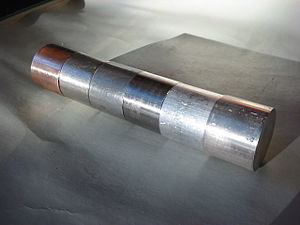Term: Alloy
**Alloy Characteristics and Classification**:
– Alloys are mixtures of chemical elements retaining metal characteristics.
– Made by mixing two or more elements, with at least one being a metal.
– Mechanical properties differ from individual constituents.
– Can form solid solutions or heterogeneous microstructures.
– Classified as substitutional or interstitial based on atomic arrangement.
– Can be homogeneous or heterogeneous, solid solutions, or mixtures of metallic phases.
**Impurities in Alloys and Alloying Process**:
– Impurities are usually undesirable elements in alloys.
– Introduced from base metals and alloying elements.
– Common impurities include sulfur in steel and lithium in aluminum.
– Oxygen combines with metals to form oxides during alloying.
– Removed during processing to enhance material properties.
– Alloying involves combining a metal with other elements using various methods.
**Applications and Effects of Alloying**:
– Alloys used in diverse applications from buildings to aerospace.
– Steel alloys common in construction, automotive, and surgical tools.
– Titanium alloys for aerospace, beryllium-copper for non-sparking tools.
– Alloying enhances properties like strength, hardness, and corrosion resistance.
– Adding elements creates internal stresses, alters properties like conductivity and density.
– Engineering properties like tensile strength and ductility vary in alloys.
**Alloy Behavior and Heat Treatment**:
– Most alloys have a melting range, not a single melting point.
– Specific proportions like eutectic mixtures give unique melting points.
– Alloys with impurities may exhibit different properties.
– Heat treatment alters crystalline phases and properties.
– Precipitation hardening alloys depend on diffusion for strength.
**Historical Development and Examples**:
– Meteoric iron, bronze, brass, amalgams, and precious metals in ancient civilizations.
– Discovery of alloys like duralumin and age-hardening alloys.
– Evolution of steel production methods and alloy steel development.
– Specialized steel alloys like high-speed steel and stainless steel.
– Discoveries of aluminum-copper alloys, chromium, vanadium, tungsten, and cobalt.
An alloy is a mixture of chemical elements of which at least one is a metal. Unlike chemical compounds with metallic bases, an alloy will retain all the properties of a metal in the resulting material, such as electrical conductivity, ductility, opacity, and luster, but may have properties that differ from those of the pure metals, such as increased strength or hardness. In some cases, an alloy may reduce the overall cost of the material while preserving important properties. In other cases, the mixture imparts synergistic properties to the constituent metal elements such as corrosion resistance or mechanical strength.

In an alloy, the atoms are joined by metallic bonding rather than by covalent bonds typically found in chemical compounds. The alloy constituents are usually measured by mass percentage for practical applications, and in atomic fraction for basic science studies. Alloys are usually classified as substitutional or interstitial alloys, depending on the atomic arrangement that forms the alloy. They can be further classified as homogeneous (consisting of a single phase), or heterogeneous (consisting of two or more phases) or intermetallic. An alloy may be a solid solution of metal elements (a single phase, where all metallic grains (crystals) are of the same composition) or a mixture of metallic phases (two or more solutions, forming a microstructure of different crystals within the metal).
Examples of alloys include red gold (gold and copper), white gold (gold and silver), sterling silver (silver and copper), steel or silicon steel (iron with non-metallic carbon or silicon respectively), solder, brass, pewter, duralumin, bronze, and amalgams.
Alloys are used in a wide variety of applications, from the steel alloys, used in everything from buildings to automobiles to surgical tools, to exotic titanium alloys used in the aerospace industry, to beryllium-copper alloys for non-sparking tools.
